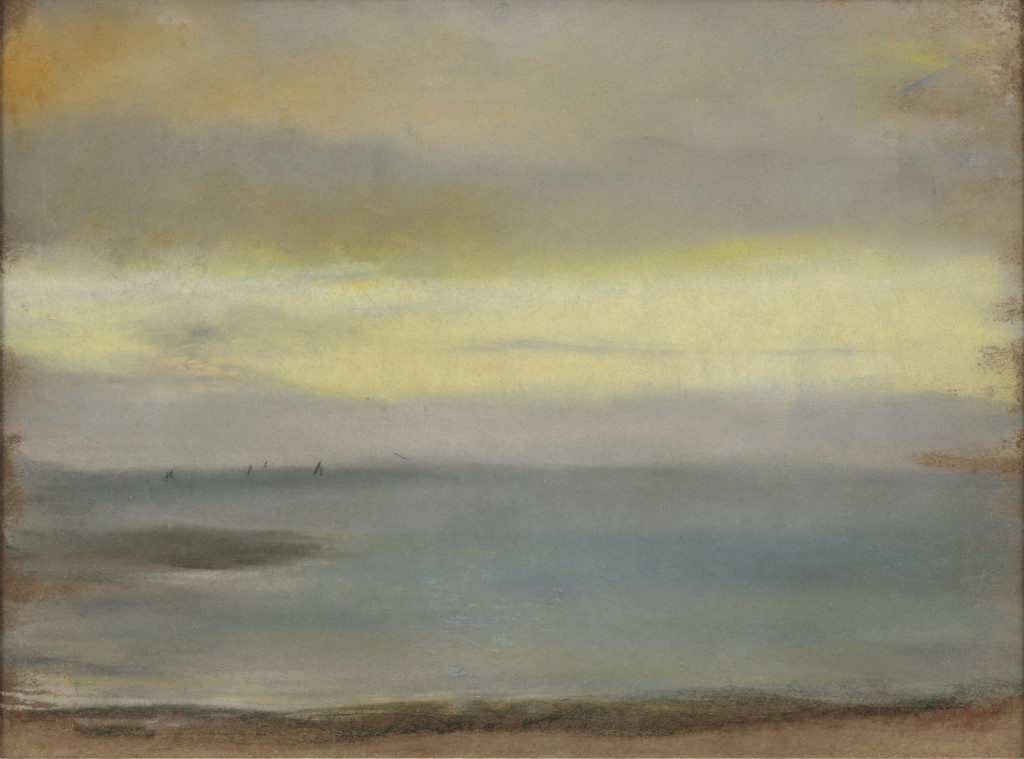Edgar Degas (1834 - Paris - 1917)
Marine, Soleil Couchant, 1869
Pastel on paper, 23.5 x 31.4 cm
Stamped with the Degas vente stamp in red ink (Lugt 658)
Provenance:
Paris, Galeries Georges Petit, Atelier Edgar Degas (4ème vente), 2-4 July 1919, lot 25a
Nunes and Figuet, Paris
Captain R. A. Peto, Isle of Wight
Moss S. Myers, Esq.
Estate of the above; London, Sotheby’s, auction sale, 6 June 1945, lot 151
The Lefevre Gallery, London (purchased at the above sale)
John Hay Whitney, Manhasset (acquired from the above on 12 June 1945)
New York, Sotheby’s, auction sale, 15 November 1984, lot 106
Mr. and Mrs. John Robertson
London, Sotheby’s, auction sale, 9 February 2005
Simon Dickinson Gallery, New York
Private collection, USA
Exhibited:
European Masters, London, Marlborough Fine Art, 1969-70, no. 13, repr.
Edgar Degas 1834/84, Pastelle, Ölskizzen, Zeichnungen, Kunsthalle Tübingen and West Berlin, Nationalgalerie, 1984, no. 78
Degas Landscapes, New York, Metropolitan Museum of Art and Houston, Museum of Fine Arts, 1994, no. 23
Peindre le Ciel: de Turner à Monet, Marly-le-Roi / Louveciennes, Musée-Promenade, 1995, no. 134, repr.
Literature:
Denis Rouart, Degas: A la recherche de sa technique, Paris, 1945, p. 71
Paul-André Lemoisne, Degas et son œuvre, Paris, 1946, II, no. 240, repr. p. 117
Eugenia Parry Janis, ‘The Role of the Monotype in the Working Method of Degas’, in The Burlington Magazine, CIX, 766-7, January-February 1967, p. 25
F. Russoli, F. Minervino, L’Opera completa di Degas, Milan, 1970, no. 305, repr.
Richard Kendall, Degas Landscapes, New Haven, 1993, p. 102, fig. 85
This fine seascape by Edgar Degas belongs to an important group of pastels conceived during his sojourn on the Normandy coast near Cabourg and Villers-sur-Mer in the summer and autumn of 1869. Most scholars share the view that the pastels were executed en plein-air. Their modernity is defined by a total lack of narrative elements. They propose subtle variations on the theme of sea mist, sunlit haze and impending rain. The group marks Degas’s first experiment with seascapes and represents a more radical approach than Gustave Courbet’s Normandy seascapes. Degas had probably seen Courbet’s seascapes when they were exhibited in Paris in 1867. As Richard Kendall has noted of Degas’s Normandy pastels: Nowhere do we find the familiar conceits and trickery of the conventional landscape painter: trees do not frame our field of view, nor do pathways and avenues indicate recession; beetling cliffs and ominous ruins are not in evidence, and industrious mariners offer no uplifting narrative. The image might almost be defined by such absences, were it not for the spaces that are opened up and the expressive potential generated. In this understated world, simple oppositions of colours evoke weather and light, atmosphere and gravity.[1] In the 1860s, contemporary artists like James McNeill Whistler, Eugene Boudin and Berthe Morisot shared Degas’s and Courbet’s interest in these ‘subjectless’ Normandy landscapes.
Kendall further notes: Many of the pastels appear to have been improvised freely on the paper in broad areas of tone and hue, their contours and formal components modified as the composition progressed. Where line is used, it is either a generalised, subordinate laying-in of principal forms, or a final sharpening of detail, executed with the edge of the pastel stick. In either case, Degas's technique represents the antithesis of the Ingresque tradition, a shameless and temporary triumph of colour over line which had no equal in his oeuvre until the landscape monotypes of the 1890s.
Degas’s choice of the medium of pastel enabled him to respond in a matter of minutes, rather than hours or days, to the subjects he encountered. These pastels are notably free of the latter-day Romanticism of Courbet’s generation and unmarked by the nascent aestheticism of Whistler’s art. Degas would go on to develop a distinct preference for the medium of pastel, using it almost exclusively from the 1880s onwards.
It can be surmised that Degas intended the signed sheets in the group of Normandy landscapes as exhibition pieces – despite their modest proportions and relative lack of finish – and that he planned to market them through the art dealers he and his colleagues knew in Paris and London.
[1] Richard Kendall, Degas Landscapes, New Haven and London 1993, pp. 86-106.

